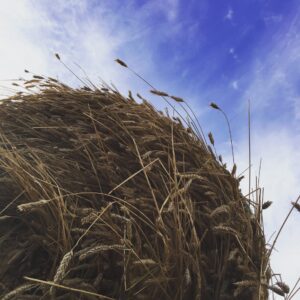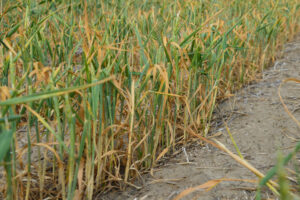Don't Let High Nitrates Sneak Up on Your Herd 🎙️
CLICK THE PLAY BUTTON TO LISTEN TO THIS POST:
Listen to more episodes on BeefResearch.ca, Spotify, Apple Podcasts, Amazon Music or Podbean.
Nitrates can become a serious problem in beef cattle diets when consumed at high levels. Knowing how nitrates work, why they are a risk and how to manage them can help protect both your cattle and your bottom line.

Why Are High Nitrates a Problem for Beef Cattle?
When nitrates (NO3-) are consumed at low concentrations, rumen microbes can effectively convert them to nitrite (NO2) and then further to ammonia (NH3) to produce proteins. However, if nitrates are consumed at high concentrations, this metabolic process becomes overwhelmed, leading to a buildup of nitrite. This excess spills over into the bloodstream and binds to hemoglobin, reducing the blood’s oxygen-carrying capacity. The result is similar to carbon monoxide poisoning and is a medical emergency, as cattle can die quickly. If you suspect your cattle have nitrate poisoning, contact your veterinarian immediately.
When Are Nitrates the Biggest Risk?
Nitrates pose the biggest risk to cattle when plants have accumulated levels above what can be converted to plant protein – usually during stressful growing conditions such as heat stress, drought, frost and hail damage. These events result in an inhibition of the plants’ ability to process nitrates effectively. Elevated nitrate levels can also occur with excess nitrogen fertilization.
Annual crops such as canola, wheat, corn, oats, barley, sorghum, Sudan grass, millet and rye, along with common weeds like kochia, thistle, pigweed, lambs quarter, dock and sweet clover, are more susceptible to nitrate accumulation. Harvesting annual crops as dry, baled forage or greenfeed can be of particular risk as the drying process will not reduce nitrate levels. Grazing stubble fields of nitrate-accumulating plants, such as canola or corn, can also pose a danger. There is a much smaller risk of nitrate poisoning from perennial forages. Alfalfa, for example, stores nitrogen in the roots and only moves it to the rest of the plant when needed.
Symptoms of Nitrate Poisoning in Cattle
Symptoms of nitrate poisoning include:

- Reduced feed intake
- Weakness or reluctance to move
- Staggering
- Muscle tremors or convulsions
- Abortions
- Brown, muddy gums
- Respiratory distress
- Collapse
- Death
Sampling Feed for Nitrate Testing
To effectively manage nitrates in beef cattle diets, a feed test is needed. Nitrate levels can only be determined through laboratory analysis. Any feed suspected of having elevated nitrates should be tested.
A test result is only reliable if a good sample was submitted. Follow recommended procedures for collecting feed samples.
Interpreting Nitrate Levels
Different labs will report nitrate levels in different ways, such as percent of dry matter (% DM), parts per million (ppm) NO3- or nitrate-nitrogen (NO3-– N). Some labs offer a screening test (a “presence/absence” test) while others can quantify the amount of nitrate in the feed. Check with the lab for which test is used.
Below are conversion formulas to help you determine the level of nitrates in your feed:
Work closely with your nutritionist to interpret nitrate test results and balance rations.
- Nitrate nitrogen (NO3-N) x 4.43 = Nitrate (NO3-)
- Potassium nitrate (KNO3) x 0.613 = Nitrate (NO3-)
- Sodium nitrate (NaNO3) x 0.729 = Nitrate (NO3-)
- Nitrite nitrogen (NO2-N) x 3.29 = Nitrate (NO3-)
The recommended safe level for nitrate consumption by cattle is <0.5% on a dry matter basis. This is the level in the total diet (feed and water combined). The table below provides a guideline for interpreting nitrate levels:
Feed Testing Interpretation Guidelines
| Recommendation | Nitrate (NO3) | Nitrate nitrogen (NO3-N) | Potassium nitrate (KNO3) |
|---|---|---|---|
| Generally safe for livestock use. | <0.5% DM <5000 ppm | <0.12% <1200 ppm | <1% <10 000 ppm |
| Use with caution. Feed should be blended with low-nitrate forage to reduce risk. Avoid feeding to pregnant cattle. | 0.5-1.0% DM 5000-10 000 ppm | 0.1-0.2% 1000-2000 ppm | 1.0-1.6% 10 000-16 000 ppm |
| Dangerous. High risk of poisoning. Dilute feed significantly to lower nitrate intake. | >1.0% DM or higher >10 000 ppm | >0.2% DM >2000 ppm | >1.6% >16 000 |
Management Tips When Dealing with High Nitrate Feeds
- Test before feeding. Test all suspect feed to determine nitrate levels.
- Don’t forget about water. Nitrates can build up in water sources and should be tested prior to livestock consumption. Visit the BCRC Water Systems for Beef Cattle webpage for more information on water quality and testing.
- Avoid feeding to young, hungry, pregnant or lactating animals. These groups are more susceptible to nitrate poisoning.
- Blend high-nitrate feeds. Mix with low-nitrate feeds to reduce the risk of poisoning. If mixing is not an option, put low-nitrate feed at the beginning of each feeding and follow up with higher-nitrate feed to ensure each animal has consumed the low-nitrate feed first.
- Introduce high-nitrate feeds gradually. Allow the rumen time to adapt to moderate nitrate levels over time. Caution: cattle can lose tolerance to moderate nitrate feeds quickly, so do not feed intermittently.
- Make harvest adjustments. Consider increasing cutting height at harvest to avoid the nitrate-rich stems.
- Delay grazing. Wait 10-14 days to graze forages that have experienced stressful conditions to allow nitrates to dissipate. Caution: delay timing further if plants experience another stressful event.
- Provide adequate energy. Feeding a high-energy supplement, such as grain, can help the rumen to metabolize nitrates into protein more effectively.
- Ensile feeds. Ensiling can reduce the nitrate content, but forage quality will be reduced. Caution: test prior to feeding as there is no guarantee the ensiled feed will reach safe levels.
Proper management and feed testing are required for high-nitrate feeds to be utilized safely. The key is to know your numbers before the feed hits the bunk.
ACKNOWLEDGEMENT:
Thank you to the livestock and feed extension specialists with the Saskatchewan Ministry of Agriculture and Dr. Vanessa Cowan, DVM, with the Western College of Veterinary Medicine, for sharing their expertise on this topic.
Sharing or reprinting BCRC posts is welcome and encouraged. Please credit the Beef Cattle Research Council, provide the website address, www.BeefResearch.ca, and let us know you have chosen to share the article by emailing us at [email protected].
Your questions, comments and suggestions are welcome. Contact us directly or spark a public discussion by posting your thoughts below.